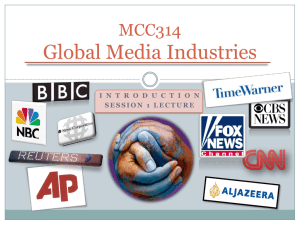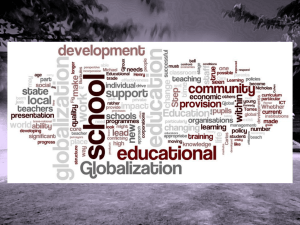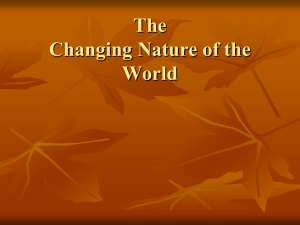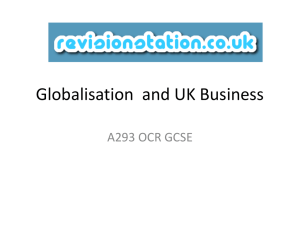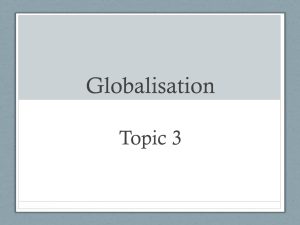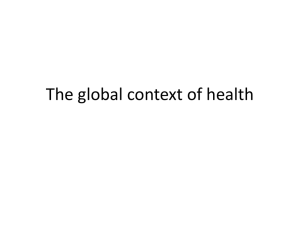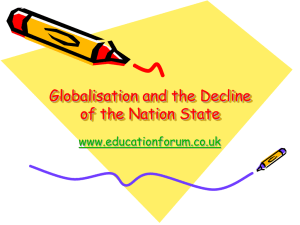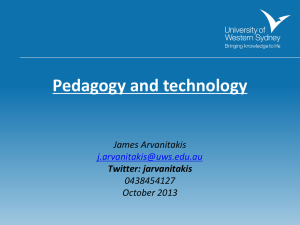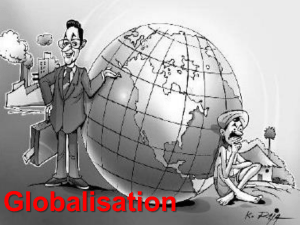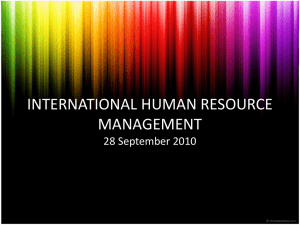Ch 7 - Webs
advertisement
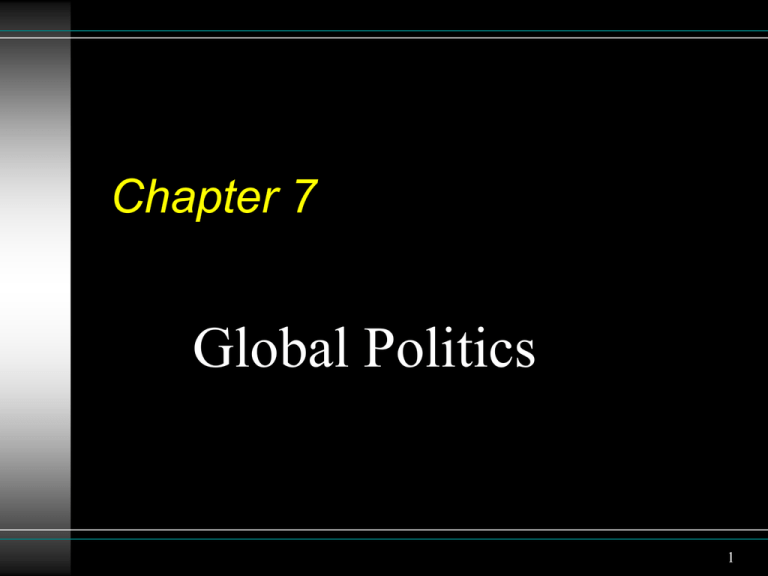
Chapter 7 Global Politics 1 ‘War, in our scientific age, means, sooner or later, universal death’. Bertrand Russell Unpopular Essays (1950) 2 Key issues • How has international or world politics been analysed and explained? • What is globalisation? What are its implications for the nation-state? • Is globalisation a beneficial or a destructive force? • Could the idea of a world government ever become a reality? 3 Understanding world politics The major theoretical ‘schools’ of international politics are the following: • idealism • realism • pluralism • Marxism 4 Idealism • The defining characteristic of idealism is that it views international politics from the perspective of moral values and legal norms. It is concerned less with empirical analysis (i.e., with how international actors behave) than with normative judgements (i.e., with how they should behave). • Therefore, idealism is sometimes seen a species of utopianism. 5 Realism • The realist tradition, sometimes called ‘political realism’, can claim to be the oldest theory of international politics. • It can be traced back to Sun Tzu’s classic work on strategy, the Art of War, in China. • Realism is grounded in an emphasis on power politics and the pursuit of national interests. • Its central assumption is that the state is the principle actor on the international or world stage, and, being sovereign, is able to act as an autonomous entity. 6 Pluralism • Pluralism is a socio-political theory that emphasised the diffusion of power amongst a number of competing bodies or groups. As a theory of international politics, it highlights the permeability of the state, and provides an alternative to the state-centrism of the realist model. 7 Marxism • What makes the Marxist approach distinctive is its stress on economic power and the role played by international capital. • The global structure of production and exchange is highly ordered in the sense that it has divided the world into ‘core’ and ‘peripheral’ areas. Core areas e.g. the developed North benefit from technological innovation and high and sustained levels of investment, while peripheral areas e.g. the less developed South provide a source of cheap labour, and are often dependent on cash crops. 8 Dynamics of globalisation • Globalisation - It is the emergence of a complex web of interconnectedness that means that our lives are increasingly shaped by events that occur, and decisions that are made, at a great distance from us. - The central feature of globalisation is therefore that geographical distance is of declining relevance, and that territorial boundaries, e.g. those between nation-states, are becoming less significant. 9 System interdependences Global National Local National Local 10 • The interconnectedness that globalisation has spawned is multidimensional. The popular image of globalisation is that it is a top-down process, the establishment of a single global system that imprints itself on all parts of the world. 11 • Globalisation as ‘a shift from a world of distinct national economies to a global economy in which production is internationalised and financial capital flows freely and instantly between countries. the OECD (1995) Organisation for Economic Cooperation and Development 12 • Political globalisation is evident in the growing importance of international organisations. These are organisations that are trans-national in that they exercise jurisdiction not within a single state, but within an international area comprising several states. Most such organisations have emerged in the post-1945 period: e.g. UN, NATO, European Economic Community, World Bank, IMF, OECD and WTO. 13 United Nations Headquarters, New York 14 Globalisation: theories and debates • The most intense debate about globalisation nevertheless concerns its implications for equality and poverty. Critics of globalisation have drawn attention to the emergence of new and deeply entrenched patterns of inequality: globalisation is thus a game of winners and losers. • Globalisation has also been criticised because if its tendency towards risk, uncertainty and instability. (financial markets, rising individualism and an associated weakening of tradition, community and established institutions) 15 • The most significant political debate associated with globalisation concerns its impact on democracy. • Supporters: major factor underpinning the trend towards democratisation; economic freedom is inevitably associated with political freedom. 16 • Opponents: - multinational corporations are allied to the ability to manipulate consumer tastes and entrench materialist values through the development of brands; are provided with cheap labour and low production costs without longterm investments. - Democracy is threatened by the fact that the pace of economic globalisation far outstrips that of political globalisation. 17 Regionalisation • Regionalisation has been fuelled by strategic, economic and, possibly, cultural factors. • The most significant impetus towards international regionalisation is undoubtedly economic. • A further dimension of regionalisation is cultural. 18 The forerunner to the European Union was formed by six countries in 1952 and now has 28 members with a combined population of more than 500 million people. 19 20 Towards World Government? • The logic behind the idea of world government is the same as that which underlies the classic liberal justification for the state– social-contract theory. Just as the only means of ensuring order and stability amongst individuals with different interests is to establish a sovereign state, the only way of preventing international conflict between states each pursuing its national interest is to create a supreme world power. 21 The United Nations • The UN, constructed at the San Francisco Conference (1945) in the dying days of the Second World War, is the most advanced experiment in world government to date. • Franklin D. Roosevelt expresses that this period would be marked by a rejection of the power politics of the past, paving the way for an era of peace and international cooperation. 22 The UN structure: - General Assembly (193 member states since 2011) - Security Council (15 members, ‘big five’ are permanent ‘veto powers’, and the other ten are non-permanent members elected every two years) - The World Court (formerly the International Court of Justice) (in the Hague, Netherlands, consists of a panel of 15 judges elected for nineyear terms) 23 United Nations Headquarters, New York 24 International Court of Justice 25 WTO Headquarters, Geneva, Switzerland 26
